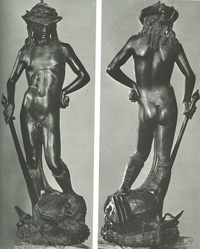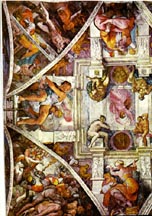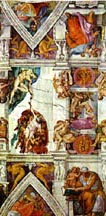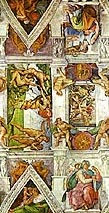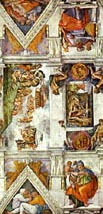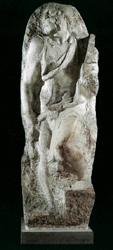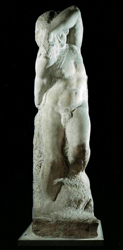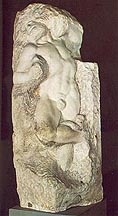Art
Home | ARTH Courses | ARTH
200 Assignments
Excerpt from Giorgio Vasari, Lives of the Artists:
Michelangelo
BUONAROTTI of Florence, Painter, Sculptor and Architect
(1475-1564)
Excerpts
(an unexcerpted version of the biography of Michelangelo)
For primary documents concerning Michelangelo's career, samples of Michelangelo's poems, and Vasari's biography of Michelangelo see the pdf on the Columbia University Art and Humanities site.
WHILE industrious and choice
spirits, aided by the light afforded by Giotto and his followers, strove to
show the world the talent with which their happy stars and well-balanced humours
had endowed them, and endeavoured to attain to the height of knowledge by imitating
the greatness of Nature in all things, the great Ruler of Heaven looked down
and, seeing these vain and fruitless efforts and the presumptuous opinion of
man more removed from truth than light from darkness, resolved, in order to
rid him of these errors, to send to earth a genius universal in each art, to
show single-handed the perfection of line and shadow, and who should give relief
to his paintings, show a sound judgment in sculpture, and in architecture should
render habitations convenient, safe, healthy, pleasant, well-proportioned, and
enriched with various ornaments. He further endowed him with true moral philosophy
and a sweet poetic spirit, so that the world should marvel at the singular eminence
of his life and works and all his actions, seeming rather divine than earthy.
[Contrast this introduction to that of Cennino Cennini's Craftsman's Handbook.]
In the arts of painting,
sculpture and architecture the Tuscans have always been among the best, and
Florence was the city in Italy most worthy to be the birthplace of such a citizen
to crown her perfections. Thus in 1474 the true and noble wife of Ludovico di
Lionardo Buonarotti Simone, said to be of the ancient and noble family of the
Counts of Canossa, gave birth to a son in the Casentino, under a lucky star.
The son was born on Sunday, 6 March, at eight in the evening, and was called
Michelangelo, as being of a divine nature, for Mercury and Venus were in the
house of Jove at his birth, showing that his works of art would be stupendous.
Ludovico at the time was
podesta at Chiusi and Caprese near the Sasso della Vernia, where St. Francis
received the stigmata, in the diocese of Arezzo. On laying down his office Ludovico
returned to Florence, to the villa of Settignano, three miles from the city,
where he had a property inherited from his ancestors, a place full of rocks
and quarries of macigno which are constantly worked by stonecutters and sculptors
who are mostly natives. There Michelangelo was put to nurse with a stonecutter's
wife. Thus he once said jestingly to Vasari: "What good I have comes from
the pure air of your native Arezzo, and also because I sucked in chisels and
hammers with my nurse's milk." In time Ludovico had several children, and
not being well off, he put them in the arts of wool and silk. Michelangelo,
who was older, he placed with Maestro Francesco da Urbino to school. But the
boy devoted all the time he could to drawing secretly, for which his father
and seniors scolded and sometimes beat him, thinking that such things were base
and unworthy of their noble house....

During his stay in Rome
he made such progress in art that his conceptions were marvellous, and he executed
difficulties with the utmost ease, frightening those who were not accustomed
to see such things, for when they were done the works of others appeared as
nothing beside them. Thus the cardinal of St. Denis, called Cardinal Rohan,
a Frenchman, desired to leave a memorial of himself in the famous city by such
a rare artist, and got him to do a marble Pieta, which was placed in the chapel
of S. Maria della Febbre in the temple of Mars, in S. Pietro. The rarest artist
could add nothing to its design and grace, or finish the marble with such polish
and art, for it displays the utmost limits of sculpture. Among its beauties
are the divine draperies, the foreshortening of the dead Christ and the beauty
of the limbs with the muscles, veins, sinews, while no better presentation of
a corpse was ever made. 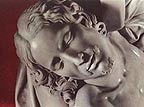 The
sweet air of the head and the harmonious joining of the arms and legs to the
torso, with the pulses and veins, are marvellous, and it is a miracle that a
once shapeless stone should assume a form that Nature with difficulty produces
in flesh. Michelangelo devoted so much love and pains on this work that he put
his name on the girdle crossing the Virgin's breast, a thing he never did again.
One morning he had gone to the place to where it stands and observed a number
of Lombards who were praising it loudly. One of them asked another the name
of the sculptor, and he replied, "Our Gobbo of Milan." Michelangelo
said nothing, but he resented the injustice of having his work attributed to
another, and that night he shut himself in the chapel with a light and his chisels
and carved his name on it. It has been thus aptly described:
The
sweet air of the head and the harmonious joining of the arms and legs to the
torso, with the pulses and veins, are marvellous, and it is a miracle that a
once shapeless stone should assume a form that Nature with difficulty produces
in flesh. Michelangelo devoted so much love and pains on this work that he put
his name on the girdle crossing the Virgin's breast, a thing he never did again.
One morning he had gone to the place to where it stands and observed a number
of Lombards who were praising it loudly. One of them asked another the name
of the sculptor, and he replied, "Our Gobbo of Milan." Michelangelo
said nothing, but he resented the injustice of having his work attributed to
another, and that night he shut himself in the chapel with a light and his chisels
and carved his name on it. It has been thus aptly described:
Bellezza ed onestate
E doglia e pieta on vivo marmo morte,
Deh, come voi pur fate
Nort piangete si forte
Che anzi tempo risveglisi da morte
E pur, mai grado suo
Nostro Signore e tuo
Sposo, figliuolo e padre
Unica sposa sua figliuola e madre.
|
 It
brought him great renown, and though some fools say that he has made the Virgin
too young, they ought to know that spotless virgins keep their youth for a long
time, while people afflicted like Christ do the reverse, so that should contribute
more to increase the fame of his genius than all the things done before.
It
brought him great renown, and though some fools say that he has made the Virgin
too young, they ought to know that spotless virgins keep their youth for a long
time, while people afflicted like Christ do the reverse, so that should contribute
more to increase the fame of his genius than all the things done before.
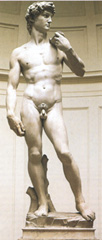
Some of Michelangelo's friends
wrote from Florence urging him to return, as they did not want that block of
marble on the opera to be spoiled which Piero Soderini, then gonfaloniere for
life in the city, had frequently proposed to give to Leonardo da Vinci, and
then to Andrea Contucci, an excellent sculptor, who wanted it. Michelangelo
on returning tried to obtain it, although it was difficult to get an entire
figure without pieces, and no other man except himself would have had the courage
to make the attempt, but he had wanted it for many years, and on reaching Florence
he made efforts to get it. It was nine braccia high, and unluckily one Simone
da Fiesole had begun a giant, cutting between the legs and mauling it so badly
that the wardens of S. Maria del Fiore had abandoned it without wishing to have
it finished, and it had rested so for many years. Michelangelo examined it afresh,
and decided that it could be hewn into something new while following the attitude
sketched by Simone, and he decided to ask the wardens and Soderini for it. They
gave it to him as worthless, thinking that anything he might do would be better
than its present useless condition.
Accordingly Michelangelo
made a wax model of a youthful David holding the sling to show that the city
should be boldly defended and righteously governed, following David's example.
He began it in the opera, making a screen between the wall and the tables, and
finished it without anyone having seen him at work. The marble had been hacked
and spoiled by Simone so that be could not do all that he wished with it, though
he left some of Simone's work at the end of the marble, which may still be seen.
This revival of a dead thing was a veritable miracle.
righteously governed, following David's example.
He began it in the opera, making a screen between the wall and the tables, and
finished it without anyone having seen him at work. The marble had been hacked
and spoiled by Simone so that be could not do all that he wished with it, though
he left some of Simone's work at the end of the marble, which may still be seen.
This revival of a dead thing was a veritable miracle. 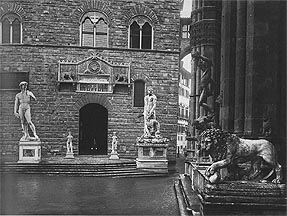 When it was finished various
disputes arose as to who should take it to the piazza of the Signori, so Giuliano
da Sangallo and his brother Antonio made a strong wooden frame and hoisted the
figure on to it with ropes; they then moved it forward by beams and windlasses
and placed it in position. The knot of the rope which held the statue was made
to slip so that it tightened as the weight increased, an ingenious device, the
design for which is in our book, showing a very strong and safe method of suspending
heavy weights. Piero Soderini came to see it, and expressed great pleasure to
Michelangelo who was retouching it, though he said he thought the nose large.
Michelangelo seeing the gonfaloniere below and knowing that he could not see
properly, mounted the scaffolding and taking his chisel dexterously let a little
marble dust fall on to the gonfaloniere,
When it was finished various
disputes arose as to who should take it to the piazza of the Signori, so Giuliano
da Sangallo and his brother Antonio made a strong wooden frame and hoisted the
figure on to it with ropes; they then moved it forward by beams and windlasses
and placed it in position. The knot of the rope which held the statue was made
to slip so that it tightened as the weight increased, an ingenious device, the
design for which is in our book, showing a very strong and safe method of suspending
heavy weights. Piero Soderini came to see it, and expressed great pleasure to
Michelangelo who was retouching it, though he said he thought the nose large.
Michelangelo seeing the gonfaloniere below and knowing that he could not see
properly, mounted the scaffolding and taking his chisel dexterously let a little
marble dust fall on to the gonfaloniere,  without, however, actually altering
his work. Looking down he said, "Look now." "I like it better,"said
the gonfaloniere, "you have given it life." Michelangelo therefore
came down with feelings of pity for those who wish to seem to understand matters
of which they know nothing. When the statue was finished and set up Michelangelo
uncovered it. It certainly bears the palm among all modern and ancient works,
whether Greek or Roman, and the Marforio of Rome, the Tiber and Nile of Belvedere,
and the colossal statues of Montecavallo do not compare with it in proportion
and beauty. The legs are finely turned, the slender flanks divine, and the graceful
pose unequalled, while such feet, hands and head have never been excelled. After
seeing this no one need wish to look at any other sculpture or the work of any
other artist. Michelangelo received four hundred crowns from Piero Soderini,
and it was set up in 15O4....
without, however, actually altering
his work. Looking down he said, "Look now." "I like it better,"said
the gonfaloniere, "you have given it life." Michelangelo therefore
came down with feelings of pity for those who wish to seem to understand matters
of which they know nothing. When the statue was finished and set up Michelangelo
uncovered it. It certainly bears the palm among all modern and ancient works,
whether Greek or Roman, and the Marforio of Rome, the Tiber and Nile of Belvedere,
and the colossal statues of Montecavallo do not compare with it in proportion
and beauty. The legs are finely turned, the slender flanks divine, and the graceful
pose unequalled, while such feet, hands and head have never been excelled. After
seeing this no one need wish to look at any other sculpture or the work of any
other artist. Michelangelo received four hundred crowns from Piero Soderini,
and it was set up in 15O4....
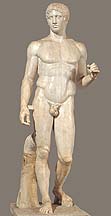
Polykleitos, Doryphoros, c. 440 BCE
|
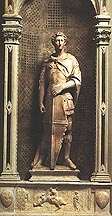
Donatello, St. George
|
|
When Leonardo da Vinci
was painting in the Great Hall of the Council, as related in his Life, Piero
Soderini,
the gonfaloniere, his great genius, and the artist chose the war of Pisa as
his subject. He was given a room in the dyers' hospital at S. Onofrio, and
there
began a large cartoon which he allowed no one to see. He filled it with nude figures bathing in the Arno owing to the heat, and running
in this condition to their arms on being attacked by the enemy. He represented
them hurrying out of the water to dress, and seizing their arms to go to assist their
comrades, some buckling their cuirasses and many putting on other armour,
while
others on horseback are beginning the fight. Among other figures is an old
man wearing a crown of ivy to shade his head trying to pull his stockings
on to
his wet feet, and hearing the cries of the soldiers and the beating of the
drums he is struggling violently, all his muscles to the tips of his toes
and his
contorted mouth showing the effects of the exertion. It also contained drums
and nude figures with twisted draperies running to the fray, foreshortened
in
extraordinary attitudes, some upright, some kneeling, some bent, and some lying.
There were also many groups sketched in various ways, some merely outlined
in
carbon, some with features filled in, some hazy or with white lights, to show
his knowledge of art. And indeed artists were amazed when they saw the lengths
he had reached in this cartoon. Some in seeing his divine figures declared
that it was impossible for any other spirit to attain to its divinity. When
finished
it was carried to the Pope's hall amid the excitement of artists and to the
glory of Michelangelo, and all those who studied and drew from it, as foreigners
and natives did for many years afterwards, became excellent artists, as we
see by Aristotile da Sangallo, his friend, Ridolfo Ghirlandaio, Raphael Sanzio,
Francesco Granaccio, Baccio Bandinelli, Alonso Berugetta a Spaniard, with Andrea
del Sarto, Franciabigio, Jacopo Sansovino, Rosso, Maturino, Lorenzetto, Tribolo,
then a child, Jacopo da Pontormo, and Perino del Vaga, all great Florentine
masters. Having become a school for artists, this cartoon was taken to the
great
hall of the Medici palace, where it was entrusted too freely to artists, for
during the illness of Duke Giuliano it was unexpectedly torn to pieces and
scattered
in many places, some fragments still being in the house of M. Uberto Strozzi,
a Mantuan noble, where they are regarded with great reverence, indeed they
are
more divine than human.
He filled it with nude figures bathing in the Arno owing to the heat, and running
in this condition to their arms on being attacked by the enemy. He represented
them hurrying out of the water to dress, and seizing their arms to go to assist their
comrades, some buckling their cuirasses and many putting on other armour,
while
others on horseback are beginning the fight. Among other figures is an old
man wearing a crown of ivy to shade his head trying to pull his stockings
on to
his wet feet, and hearing the cries of the soldiers and the beating of the
drums he is struggling violently, all his muscles to the tips of his toes
and his
contorted mouth showing the effects of the exertion. It also contained drums
and nude figures with twisted draperies running to the fray, foreshortened
in
extraordinary attitudes, some upright, some kneeling, some bent, and some lying.
There were also many groups sketched in various ways, some merely outlined
in
carbon, some with features filled in, some hazy or with white lights, to show
his knowledge of art. And indeed artists were amazed when they saw the lengths
he had reached in this cartoon. Some in seeing his divine figures declared
that it was impossible for any other spirit to attain to its divinity. When
finished
it was carried to the Pope's hall amid the excitement of artists and to the
glory of Michelangelo, and all those who studied and drew from it, as foreigners
and natives did for many years afterwards, became excellent artists, as we
see by Aristotile da Sangallo, his friend, Ridolfo Ghirlandaio, Raphael Sanzio,
Francesco Granaccio, Baccio Bandinelli, Alonso Berugetta a Spaniard, with Andrea
del Sarto, Franciabigio, Jacopo Sansovino, Rosso, Maturino, Lorenzetto, Tribolo,
then a child, Jacopo da Pontormo, and Perino del Vaga, all great Florentine
masters. Having become a school for artists, this cartoon was taken to the
great
hall of the Medici palace, where it was entrusted too freely to artists, for
during the illness of Duke Giuliano it was unexpectedly torn to pieces and
scattered
in many places, some fragments still being in the house of M. Uberto Strozzi,
a Mantuan noble, where they are regarded with great reverence, indeed they
are
more divine than human.

Michelangelo finished the Moses in marble, a statue of five braccia, unequalled
by any modern or ancient work. Seated in a serious attitude, he rests with one
arm on the tables, and with the other holds his long glossy beard, the hairs, so difficult to render
in sculpture, being so soft and downy that it seems as if the iron chisel must
have become a brush.
and with the other holds his long glossy beard, the hairs, so difficult to render
in sculpture, being so soft and downy that it seems as if the iron chisel must
have become a brush.  The
beautiful face, like that of a saint and mighty prince, seems as one regards
it to need the veil to cover it, so splendid and shining does it appear, and
so well has the artist presented in the marble the divinity with which God had
endowed that holy countenance. The draperies fall in graceful folds, the muscles
of the arms and bones of the hands are of such beauty and perfection, as are
the legs and knees, the feet being adorned with excellent shoes, that Moses
may now be called the friend of God more than ever, since God has permitted
his body to be prepared for the resurrection before the others by the hand of
Michelangelo. The Jews still go every Saturday in troops to visit and adore
it as a divine, not a human thing. At length he finished this part, which was
afterwards set up in S. Pietro ad Vincola....
The
beautiful face, like that of a saint and mighty prince, seems as one regards
it to need the veil to cover it, so splendid and shining does it appear, and
so well has the artist presented in the marble the divinity with which God had
endowed that holy countenance. The draperies fall in graceful folds, the muscles
of the arms and bones of the hands are of such beauty and perfection, as are
the legs and knees, the feet being adorned with excellent shoes, that Moses
may now be called the friend of God more than ever, since God has permitted
his body to be prepared for the resurrection before the others by the hand of
Michelangelo. The Jews still go every Saturday in troops to visit and adore
it as a divine, not a human thing. At length he finished this part, which was
afterwards set up in S. Pietro ad Vincola....
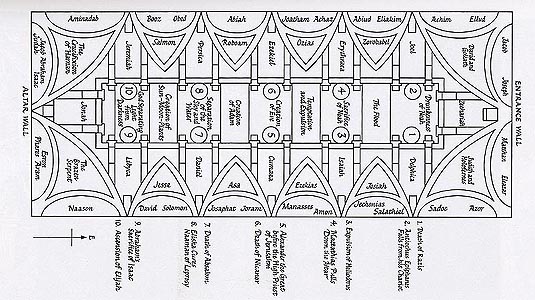
After the Pope had returned
to Rome, and when Michelangelo had finished the statue, Bramante, the friend
and relation of Raphael and therefore ill-disposed to Michelangelo, seeing
the Pope's preference for sculpture, schemed to divert his attention, and
told the
Pope that it would be a bad omen to get Michelangelo to go on with his tomb,
as it would seem to be an invitation to death. He persuaded the Pope to
get
Michelangelo, on his return, to paint the vaulting of the Sistine Chapel. In this way Bramante and his other rivals hoped to confound him, for by taking
him from sculpture, in which he was perfect, and putting him to colouring
in
fresco, in which he had had no experience, they thought he would produce less
admirable work than Raphael, and even if he succeeded he would become embroiled
with the Pope, from whom they wished to separate him. Thus, when Michelangelo
returned to Rome, the Pope was disposed not to have the tomb finished for
the
time being, and asked him to paint the vaulting of the chapel. Michelangelo
tried every means to avoid it, and recommended Raphael, for he saw the difficulty
of the work, knew his lack of skill in coloring, and wanted to finish the
tomb.
In this way Bramante and his other rivals hoped to confound him, for by taking
him from sculpture, in which he was perfect, and putting him to colouring
in
fresco, in which he had had no experience, they thought he would produce less
admirable work than Raphael, and even if he succeeded he would become embroiled
with the Pope, from whom they wished to separate him. Thus, when Michelangelo
returned to Rome, the Pope was disposed not to have the tomb finished for
the
time being, and asked him to paint the vaulting of the chapel. Michelangelo
tried every means to avoid it, and recommended Raphael, for he saw the difficulty
of the work, knew his lack of skill in coloring, and wanted to finish the
tomb.
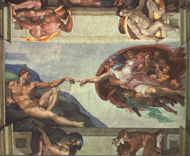
But the more he excused
himself, the more the impetuous Pope was determined he should do it, being stimulated
by the artist's rivals, especially Bramante, and ready to become incensed against
Michelangelo. At length, seeing that the Pope was resolute, Michelangelo  decided
to do it. The Pope commanded Bramante to make preparations for the painting,
and he hung a scaffold on ropes, making holes in the vaulting. When Michelangelo
asked why he had done this, as on the completion of the painting it would be
necessary to fill up the holes again, Bramante declared there was no other way.
Michelangelo thus recognised either that Bramante was incapable or else hostile,
and he went to complain to the Pope that the scaffolding would not do, and that
Bramante did not know how it should be constructed. The Pope answered, in Bramante's
presence, that Michelangelo should design one
decided
to do it. The Pope commanded Bramante to make preparations for the painting,
and he hung a scaffold on ropes, making holes in the vaulting. When Michelangelo
asked why he had done this, as on the completion of the painting it would be
necessary to fill up the holes again, Bramante declared there was no other way.
Michelangelo thus recognised either that Bramante was incapable or else hostile,
and he went to complain to the Pope that the scaffolding would not do, and that
Bramante did not know how it should be constructed. The Pope answered, in Bramante's
presence, that Michelangelo should design one  for himself. Accordingly he erected
one on poles not touching the wall, a method which guided Bramante and others
in similar work. He gave so much rope to the poor carpenter who made it, that
it sufficed, when sold, for the dower of the man's daughter, to whom Michelangelo
presented it. He then got to work on the cartoons. The Pope wanted to destroy
the work on the walls done by masters in the time of Sixtus, and he set aside
15,000 ducats as the cost, as valued by Giuliano da San Gallo. Impressed by
the greatness of the work, Michelangelo sent to Florence for help, resolving
to prove himself superior to those who had worked there before, and to show
modern artists the true way to design and paint. The circumstances spurred him
on in his quest of fame and his desire for the good of art. When he had completed
the cartoons, he waited before beginning to colour them in fresco until some
friends of his, who were painters, should arrive from Florence, as he hoped
to obtain help from them, and learn their methods of fresco-painting, in which
some of them were experienced, namely Granaccio, Giulian Dugiardini, Jacopo
di Sandro, Indaco the elder, Agnolo di Donnino and Aristotile. He made them
begin some things as a specimen, but perceiving their work to be very far from
his expectations, he decided one morning to destroy everything which they had
done, and shutting himself up in the chapel he refused to admit them, and would
not let them see him in his house. This jest seemed to them to be carried too
far, and so they took their departure, returning with shame and mortification
to Florence.
for himself. Accordingly he erected
one on poles not touching the wall, a method which guided Bramante and others
in similar work. He gave so much rope to the poor carpenter who made it, that
it sufficed, when sold, for the dower of the man's daughter, to whom Michelangelo
presented it. He then got to work on the cartoons. The Pope wanted to destroy
the work on the walls done by masters in the time of Sixtus, and he set aside
15,000 ducats as the cost, as valued by Giuliano da San Gallo. Impressed by
the greatness of the work, Michelangelo sent to Florence for help, resolving
to prove himself superior to those who had worked there before, and to show
modern artists the true way to design and paint. The circumstances spurred him
on in his quest of fame and his desire for the good of art. When he had completed
the cartoons, he waited before beginning to colour them in fresco until some
friends of his, who were painters, should arrive from Florence, as he hoped
to obtain help from them, and learn their methods of fresco-painting, in which
some of them were experienced, namely Granaccio, Giulian Dugiardini, Jacopo
di Sandro, Indaco the elder, Agnolo di Donnino and Aristotile. He made them
begin some things as a specimen, but perceiving their work to be very far from
his expectations, he decided one morning to destroy everything which they had
done, and shutting himself up in the chapel he refused to admit them, and would
not let them see him in his house. This jest seemed to them to be carried too
far, and so they took their departure, returning with shame and mortification
to Florence.
Michelangelo then made arrangements
to do the whole work singlehanded. His care and labour brought everything into
excellent train, and he would see no one in order to avoid occasions for showing
anything, so that the most lively curiosity was excited. Pope Julius was very
anxious to see his plans, and the fact of their being hidden greatly excited
his desire. But when he went one day he was not admitted. This led to the disturbance
already referred to, when Michelangelo had to leave Rome. Michelangelo has himself
told me that, when he had painted a third of the vault, a certain mouldiness
began to appear one winter when the north wind was blowing. This was because
the Roman lime, being white and made of travertine, does not dry quickly enough,
and when mixed with pozzolana, which is of a tawny colour, it makes a dark mixture.
If this mixture is liquid and watery, and the wall thoroughly wetted, it often
effloresces in drying. This happened here, where the salt effloresced in many
places, although in time the air consumed it. In despair at this, Michelangelo
wished to abandon the work, and when he excused himself, telling the Pope that
he was not succeeding, Julius sent Giuliano da San Gallo, who explained the
difficulty and taught him how to obviate it. When he had finished half, the
Pope, who sometimes went to see it by means of steps and scaffolds, wanted it
to be thrown open, being an impatient man; unable to wait until it had received
the finishing-touches. Immediately all Rome flocked to see it, the Pope being
the first, arriving before the dust of the scaffolding had been removed. Raphael,
who was excellent in imitating, at once changed his style after seeing it, and
to show his skill did the prophets and sybils in the church of Santa Maria della
Pace, while Bramante tried to have the other half of the chapel given to Raphael.
On hearing this Michelangelo
became incensed against Bramante, and pointed out to the Pope without mincing
matters many faults in his life and works, the latter of which he afterwards
corrected in the building of S. Pietro. But the Pope daily became more convinced
of Michelangelo's genius, and wished him to complete the work, judging that
he would do the other half even better. Thus, singlehanded, he completed the
work in twenty months, aided by his mixer of colours. He sometimes complained
that owing to the impatience of the Pope he had not been able to finish it as
be would have desired, as the Pope was always asking him when he would be done.
On one occasion Michelangelo replied that he would be finished when he had satisfied
his own artistic sense. "And we require you to satisfy us in getting it
done quickly," replied the Pope, adding that if it was not done soon he
would have the scaffolding down. Fearing the Pope's impetuosity. Michelangelo
finished what he had to do without devoting enough time to it, and the scaffold
being removed it was opened on All Saints day, when the Pope went there to sing
Mass amid the enthusiasm of the whole city. Like the old masters who had worked
below, Michelangelo wanted to retouch some things a secco, such as the backgrounds,
draperies, the gold ornaments and things, to impart greater richness and a better
appearance. When the Pope learned this he wished it to be done, for he heard
what he had seen so highly praised, but as it would have taken too long to reconstruct
the scaffold it remained as it was. The Pope often saw Michelangelo, and said,
"Have the chapel enriched with colours and gold, in which it is poor."
He would answer familiarly, "Holy Father, in those days they did not wear
gold; they never became very rich, but were holy men who despised wealth."
Altogether Michelangelo received 3000 crowns from the Pope for this work, and
he must have spent twenty-five on the colours. The work was executed in great
discomfort, as Michelangelo had to stand with his head thrown back, and he so
injured his eyesight that for several months he could only read and look at
designs in that posture. I suffered similarly when doing the vaulting of four
large rooms in the palace of Duke Cosimo, and I should never have finished them
had I not made a seat supporting the head, which enabled me to work lying down,
but it so enfeebled my head and injured my sight that I feel the effects still,
and I marvel that Michelangelo supported the discomfort. However, he became
more eager every day to be doing and making progress, and so he felt no fatigue,
and despised the discomfort.
The work had six corbels
on each side and one at each end, containing sibyls and prophets, six braccia
high, with the Creation of the World in the middle, down to the Flood and Noah's
drunkenness, and the generations of Jesus Christ in the lunettes. He used no
perspective or foreshortening, or any fixed point of view, devoting his energies
rather to adapting the figures to the disposition than the disposition to the
figures, contenting himself with the perfection of his nude and draped figures,
which are of unsurpassed design and excellence. This work has been a veritable
beacon to our art, illuminating all painting and the world which had remained
in darkness for so any centuries. Indeed, painters no longer care about novelties,
inventions, attitudes and draperies, methods of new expression or striking subjects
painted in different ways, because this work contains every perfection that
can be given. Men are stupefied by the excellence of the figures, the perfection
of the foreshortening, the stupendous rotundity of the contours, the grace and
slenderness and the charming proportions of the fine nudes showing every perfection;
every age, expression and form being repre- sented in varied attitudes, such
as sitting, turning, holding festoons of oak-leaves and laurel, the device of
Pope Julius, showing that his was a golden age, for Italy had yet to experience
her miseries. Some in the middle hold medals with, scenes, painted like bronze
or gold, the subject being taken from the Book of Kings. To show the greatness
of God and the perfection of art he represents the Dividing of Light from Darkness,
showing with love and art the Almighty, self-supported, with extended arms.
With fine discretion and ingenuity he then did God making the sun and moon,
supported by numerous cherubs, with marvellous foreshortening of the arms and
legs. The same scene contains the blessing of the earth and the Creation, God
being foreshortened in the act of flying, the figure following you to whatever
part of the chapel you turn. In another part he did God dividing the waters
from the land, marvellous figures showing the highest intellect and worthy of
being made by the divine hand of Michelangelo.  He
continued with the creation of Adam, God being borne by a group of little angels,
who seem also to be supporting the whole weight of the world. The venerable
majesty of God with the motion as He surrounds some of cherubs with one arm
and stretches the other to an Adam of marvellous beauty of attitude and outline,
seem a new creation of the Maker rather than one of the brush and design of
such a man. He next did the creation of our mother Eve, showing two nudes, one
in a heavy sleep like death, the other quickened by the blessing of God. The
brush of this great artist has clearly marked the difference between sleeping
and waking, and the firmness presented by the Divine Majesty, to speak humanly.
He
continued with the creation of Adam, God being borne by a group of little angels,
who seem also to be supporting the whole weight of the world. The venerable
majesty of God with the motion as He surrounds some of cherubs with one arm
and stretches the other to an Adam of marvellous beauty of attitude and outline,
seem a new creation of the Maker rather than one of the brush and design of
such a man. He next did the creation of our mother Eve, showing two nudes, one
in a heavy sleep like death, the other quickened by the blessing of God. The
brush of this great artist has clearly marked the difference between sleeping
and waking, and the firmness presented by the Divine Majesty, to speak humanly.

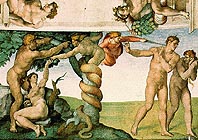 He
then did Adam eating the apple, persuaded by a figure half woman and half serpent,
and he and Eve expelled from Paradise, the angel executing the order of the
incensed Deity with grandeur and nobility, Adam showing at once grief for his
sin and the fear of death, while the woman displays shame, timidity and a desire
to obtain pardon as she clasps her arms and hands over her breast, showing,
in turning her head towards the angel, that she has more fear of the justice
than hope of the Divine mercy. No less beautiful is the sacrifice of Cain and
Abel, one bringing wood, one bending over the fire, and some killing the victim,
certaiffly not executed with less thought and care than the others. He employed
a like art and judgment in the story of the Flood, containing various forms
of death, the terrified men trying every possible means to save their lives.
Their heads show that they recognise the danger with their terror and utter
despair. Some are humanely assisting each other to climb to the top of a rock;
one of them is trying to remove a half-dead man in a very natural manner. It
is impossible to describe the excellent treatment of Noah's drunkenness, showing
incomparable and unsurpassable art. Encouraged by these he attacked the five
sibyls and seven prophets, showing himself even greater. They are of five braccia
and more, in varied attitudes, beautiful draperies and displaying miraculous
judgment and invention, their expressions seeming divine to a discerning eye.
He
then did Adam eating the apple, persuaded by a figure half woman and half serpent,
and he and Eve expelled from Paradise, the angel executing the order of the
incensed Deity with grandeur and nobility, Adam showing at once grief for his
sin and the fear of death, while the woman displays shame, timidity and a desire
to obtain pardon as she clasps her arms and hands over her breast, showing,
in turning her head towards the angel, that she has more fear of the justice
than hope of the Divine mercy. No less beautiful is the sacrifice of Cain and
Abel, one bringing wood, one bending over the fire, and some killing the victim,
certaiffly not executed with less thought and care than the others. He employed
a like art and judgment in the story of the Flood, containing various forms
of death, the terrified men trying every possible means to save their lives.
Their heads show that they recognise the danger with their terror and utter
despair. Some are humanely assisting each other to climb to the top of a rock;
one of them is trying to remove a half-dead man in a very natural manner. It
is impossible to describe the excellent treatment of Noah's drunkenness, showing
incomparable and unsurpassable art. Encouraged by these he attacked the five
sibyls and seven prophets, showing himself even greater. They are of five braccia
and more, in varied attitudes, beautiful draperies and displaying miraculous
judgment and invention, their expressions seeming divine to a discerning eye. Jeremiah, with crossed legs, holds his beard with his elbow on his knee, the
other hand resting in his lap, and his head being bent in a melancholy and thoughtful
manner, expressive of his grief, regrets, reflection, and the bitterness he
feels concerning his people. Two boys behind him show similar power; and in
the first sibyl nearer the door, in representing old age, in addition to the
involved folds of her draperies, he wishes to show that her blood is frozen
by time, and in reading she holds the book close to her eyes, her sight having
failed. Next comes
Jeremiah, with crossed legs, holds his beard with his elbow on his knee, the
other hand resting in his lap, and his head being bent in a melancholy and thoughtful
manner, expressive of his grief, regrets, reflection, and the bitterness he
feels concerning his people. Two boys behind him show similar power; and in
the first sibyl nearer the door, in representing old age, in addition to the
involved folds of her draperies, he wishes to show that her blood is frozen
by time, and in reading she holds the book close to her eyes, her sight having
failed. Next comes  Ezekiel,
an old man with fine grace and movement, in copious draperies, one hand holding
a scroll of his prophecies, the other raised and his head turned as if he wished
to declare things high and great. Behind him are two boys holding his books.
Next comes a sibyl, who, unlike the
Ezekiel,
an old man with fine grace and movement, in copious draperies, one hand holding
a scroll of his prophecies, the other raised and his head turned as if he wished
to declare things high and great. Behind him are two boys holding his books.
Next comes a sibyl, who, unlike the  Erethrian
sibyl just mentioned, holds her book at a distance, and is about to turn the
page; her legs are crossed, and she is reflecting what she shall write, while
a boy behind her is lighting her lamp. This figure has an expression of extraordinary
beauty, the hair and draperies are equally fine, and her arms are bare, and
as perfect as the other parts. He did next the Joel earnestly reading a scroll,
with the most natural expression of satisfaction at what he finds written, exactly
like one who has devoted close attention to some subject. Over the door of the
chapel Michelangelo placed the aged
Erethrian
sibyl just mentioned, holds her book at a distance, and is about to turn the
page; her legs are crossed, and she is reflecting what she shall write, while
a boy behind her is lighting her lamp. This figure has an expression of extraordinary
beauty, the hair and draperies are equally fine, and her arms are bare, and
as perfect as the other parts. He did next the Joel earnestly reading a scroll,
with the most natural expression of satisfaction at what he finds written, exactly
like one who has devoted close attention to some subject. Over the door of the
chapel Michelangelo placed the aged  Zachariah,
who is searching for something in a book, with one leg raised and the other
down, though in his eager search he does not feel the discomfort. He is a fine
figure of old age somewhat stout in person, his fine drapery falling in few
folds. There is another sibyl turned towards the altar showing writings, not
less admirable with her I" boys than the others. But for Nature herself
one must see the
Zachariah,
who is searching for something in a book, with one leg raised and the other
down, though in his eager search he does not feel the discomfort. He is a fine
figure of old age somewhat stout in person, his fine drapery falling in few
folds. There is another sibyl turned towards the altar showing writings, not
less admirable with her I" boys than the others. But for Nature herself
one must see the  Isaiah,
a figure wrapped in thought, with his legs crossed, one hand on his book to
keep the place, and the elbow of the other arm also on the volume, and his chin
in his hand. Being called by one of the boys behind, he rapidly turns his head
without moving the rest of his body. This figure, when well studied, is a liberal
education in all the principles of painting.
Isaiah,
a figure wrapped in thought, with his legs crossed, one hand on his book to
keep the place, and the elbow of the other arm also on the volume, and his chin
in his hand. Being called by one of the boys behind, he rapidly turns his head
without moving the rest of his body. This figure, when well studied, is a liberal
education in all the principles of painting.
Next to him is a beautiful
aged sibyl who sits studying a book, with extraordinary grace, matched by
the
two boys beside her. It would not be possible to add to the excellence of the
youthful Daniel, who is writing in a large book, copying with incredible
eagerness
from some writings, while a boy standing between his legs supports the weight
as he writes. Equally beautiful is the Lybica, who, having written a large
volume
drawn from several books, remains in a feminine attitude ready to rise and
shut the book, a difficult thing practically impossible for any other master.
What
can I say of the four scenes in the angles of the corbels of the vaulting?  A
David stands with his boyish strength triumphant over a giant, gripping him
by the neck while soldiers about the camp marvel. Very wonderful are the attitudes
in the story of Judith, in which we see the headless trunk of Holofernes,
while
Judith puts the head into a basket carried by her old attendant, who being
tall bends down to permit Judith to do it, while she prepares to cover it,
and turning
towards the trunk shows her fear of the camp and of the body, a well-thoughtout
painting. Finer than this and than all the rest is the story of the
A
David stands with his boyish strength triumphant over a giant, gripping him
by the neck while soldiers about the camp marvel. Very wonderful are the attitudes
in the story of Judith, in which we see the headless trunk of Holofernes,
while
Judith puts the head into a basket carried by her old attendant, who being
tall bends down to permit Judith to do it, while she prepares to cover it,
and turning
towards the trunk shows her fear of the camp and of the body, a well-thoughtout
painting. Finer than this and than all the rest is the story of the  Brazen Serpent, over the left corner of the altar, showing the death of many,
the biting of the serpents, and Moses raising the brazen serpent on a staff,
with a variety in the manner of death and in those who being bitten have lost
all hope. The keen poison causes the agony and death of many, who lie still
with twisted legs and arms, while many fine heads are crying out in despair.
Not less beautiful are those regarding the serpent, who feel their pains diminishing
with returning life. Among them is a woman, supported by one whose aid is as
finely shown as her need in her fear and distress. The scene of Ahasuerus
in
bed having the annals read to him is very fine. There are three figures eating
at a table, showing the council held to liberate the Hebrews and impale Haaman,
a wonderfully foreshortened figure, the stake supporting him and an arm stretched
out seerifing real, not painted, as do his projecting leg and the parts of
the
body turned inward. It would take too long to enumerate all the beauties and
various circumstances in the genealogy of the patriarchs, beginning with the
sons of Noah, forming the generation of Christ, containing a great variety
of draperies, expressions, extraordinary and novel fancies; nothing in fact
but
displays genius, all the figures being finely foreshortened, and everything
being admirable and divine. But who can see without wonder and amazement the
tremendous Jonah, the last figure of the chapel, for the vaulting which curves
forward from the wall is made by a triumph of art to appear straight, through
the posture of the figure, which by the mastery of the drawing and the light
and shade, appears really to be bending backwards. O, happy age O, blessed
artists
who have been able to refresh your darkened eyes at the fount of such clearness,
and see difficulties made plain by this marvellous artist! His labours have
removed the bandage from your eyes, and he has separated the true from the
false which clouded the mind. Thank Heaven, then, and try to imitate Michelangelo
in all things.
Brazen Serpent, over the left corner of the altar, showing the death of many,
the biting of the serpents, and Moses raising the brazen serpent on a staff,
with a variety in the manner of death and in those who being bitten have lost
all hope. The keen poison causes the agony and death of many, who lie still
with twisted legs and arms, while many fine heads are crying out in despair.
Not less beautiful are those regarding the serpent, who feel their pains diminishing
with returning life. Among them is a woman, supported by one whose aid is as
finely shown as her need in her fear and distress. The scene of Ahasuerus
in
bed having the annals read to him is very fine. There are three figures eating
at a table, showing the council held to liberate the Hebrews and impale Haaman,
a wonderfully foreshortened figure, the stake supporting him and an arm stretched
out seerifing real, not painted, as do his projecting leg and the parts of
the
body turned inward. It would take too long to enumerate all the beauties and
various circumstances in the genealogy of the patriarchs, beginning with the
sons of Noah, forming the generation of Christ, containing a great variety
of draperies, expressions, extraordinary and novel fancies; nothing in fact
but
displays genius, all the figures being finely foreshortened, and everything
being admirable and divine. But who can see without wonder and amazement the
tremendous Jonah, the last figure of the chapel, for the vaulting which curves
forward from the wall is made by a triumph of art to appear straight, through
the posture of the figure, which by the mastery of the drawing and the light
and shade, appears really to be bending backwards. O, happy age O, blessed
artists
who have been able to refresh your darkened eyes at the fount of such clearness,
and see difficulties made plain by this marvellous artist! His labours have
removed the bandage from your eyes, and he has separated the true from the
false which clouded the mind. Thank Heaven, then, and try to imitate Michelangelo
in all things.
When the work was uncovered
everyone rushed to see it from every part and remained dumbfounded. The Pope,
being thus encouraged to greater designs, richly rewarded Michelangelo, who
sometimes said in speaking of the great favours showered upon him by the Pope
that he fully recognised his powers, and if he sometimes used hard words, he
healed them by signal gifts and favours. Thus, when Michelangelo once asked
leave to go and spend the feast of St. John in Florence, and requested money
for this, the Pope said, "When will this chapel be ready?" "When
I can get it done, Holy Father." The Pope struck him with his mace, repeating,
"When I can, when I can, I will make you finish it !" Michelangelo,
however, returned to his house to prepare for his journey to Florence, when
the Pope sent Cursio, his chamberlain, with five hundred crowns to appease him
and excuse the Pope, who feared what Michelangelo might do. As Michelangelo
knew the Pope, and was really devoted to him, he laughed, especially as such
things always turned to this advantage, and the Pope did everything to retain
his good-will....
Michelangelo's imagination
was so perfect that, not being able to express with his hands his great and
terrible conceptions, he often abandoned his works and destroyed many of them.
I know that a little before his death he burnt a great number of drawings and
sketches. It should appear strange to none that Michelangelo delighted in
solitude, being as it were in love with art. Nevertheless he held dear the friendship
of many great and learned persons, among whom were many cardinals and bishops.
The great Cardinal Ippolito de' Medici loved him much, and once, having heard
that Michelangelo was greatly pleased with a Turkish horse of his, he sent
it to him as a gift with ten mules' burden of hay and a servant to keep it.
He loved the society of artists, and held intercourse with them; and those who
say he would not teach are wrong, for he was ready to give counsel to any one
who asked. But he was unfortunate with those pupils who lived in his house;
for Piero Urbano was a man of talent, but would never do anything to tire himself;
Antonio Mini would have done anything, but he had not a brain capable of much,
and when the wax is hard you cannot get a good impression; Ascanio dalla Ripa
Transone worked very hard, but nothing came of it: he spent years over a picture
of which Michelangelo had given him the drawing, but at last all the great
expectations that had been formed of him went off into smoke, and I remember
Michelangelo had so much compassion for his difficulty in painting that he
helped him with his own hand....
Certainly he was sent into
the world to be an example to men of art, that they should learn from his life
and from his works; and I, who have to thank God for felicity rare among men
of our profession, count among my greatest blessings that I was born in the
time when Michelangelo was alive, and was counted worthy to have him for my
master, and to be treated by him as a familiar friend, as every one knows.
Web Links:
The Influence of Neoplatonism on Michelangelo
 The
sweet air of the head and the harmonious joining of the arms and legs to the
torso, with the pulses and veins, are marvellous, and it is a miracle that a
once shapeless stone should assume a form that Nature with difficulty produces
in flesh. Michelangelo devoted so much love and pains on this work that he put
his name on the girdle crossing the Virgin's breast, a thing he never did again.
One morning he had gone to the place to where it stands and observed a number
of Lombards who were praising it loudly. One of them asked another the name
of the sculptor, and he replied, "Our Gobbo of Milan." Michelangelo
said nothing, but he resented the injustice of having his work attributed to
another, and that night he shut himself in the chapel with a light and his chisels
and carved his name on it. It has been thus aptly described:
The
sweet air of the head and the harmonious joining of the arms and legs to the
torso, with the pulses and veins, are marvellous, and it is a miracle that a
once shapeless stone should assume a form that Nature with difficulty produces
in flesh. Michelangelo devoted so much love and pains on this work that he put
his name on the girdle crossing the Virgin's breast, a thing he never did again.
One morning he had gone to the place to where it stands and observed a number
of Lombards who were praising it loudly. One of them asked another the name
of the sculptor, and he replied, "Our Gobbo of Milan." Michelangelo
said nothing, but he resented the injustice of having his work attributed to
another, and that night he shut himself in the chapel with a light and his chisels
and carved his name on it. It has been thus aptly described: 






